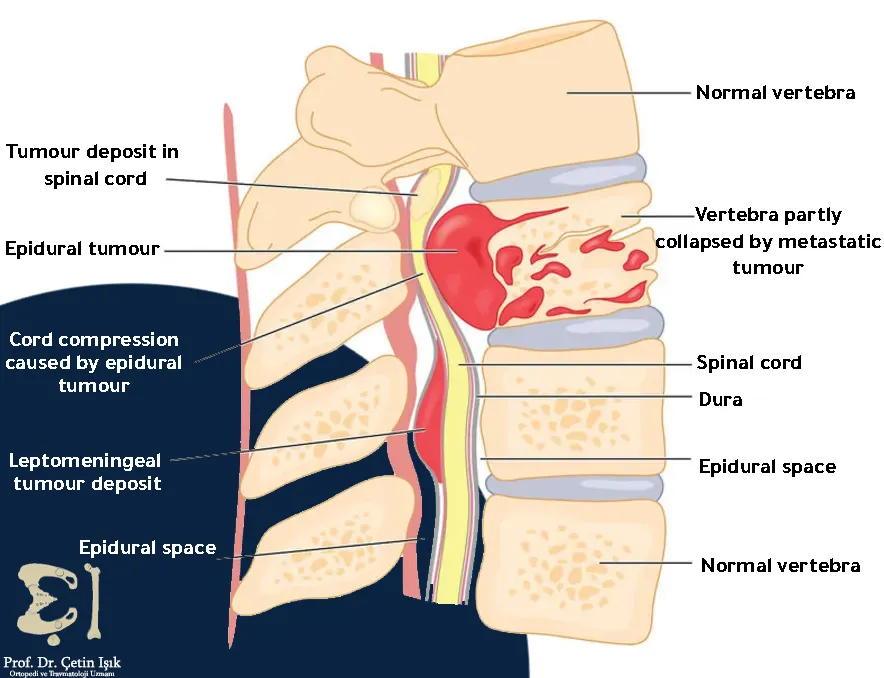Benign spinal tumors are tumors that are located around or within the spinal cord and spine. A benign tumor has a better prognosis than malignant (cancerous) tumors.
Benign tumors of the spine benign spinal tumors It is characterized by being non-cancerous; that is, it does not cause metastases to other body organs, unlike malignant tumors that cause multiple metastases to the body's organs, but despite its good warning, it should not be left untreated as it causes multiple symptoms. In this article, we will learn about spinal tumors And the difference between them and spinal cancer and what are the symptoms of spinal tumors? How to treat spinal tumors?
Information on benign spinal tumors
Spinal tumors are abnormal growth of some cells around or inside the spinal cord without the control of the mechanisms that control normal cells, and sometimes these cells grow very large without moving to other parts of the body, then the spine tumors are benign, unlike cancerous tumors that cause metastasis Either through the blood, through the lymphatic system, or by a direct route.
A benign spinal tumor may be located anywhere along the spinal cord or spine. It may be located in the cervical vertebrae or the thoracic vertebrae. It may cause symptoms of cancer of the thoracic vertebrae, or it may originate in the lumbar and sacral vertebrae.
Tumors that first arise in the spine or spinal cord are primary tumors and are rare. Tumors that spread from cancer previously present in the body to the spinal cord are secondary or metastatic tumors (metastatic spinal cancer), which are more common than primary tumors.
Locations of benign spinal tumors
It is important to know the places of placement in order to know the type of treatment that must be followed. Placement places are classified according to the following:
- Intramedullary, which is located within the spinal cord
- Within the meninges covering the spinal cord, that is, within the dura and outside the spinal cord, such as the arachnoid membrane
- Between the bones of the spine and the meninges, that it. Outside the dura
- within the bones of the vertebrae

Types of spinal tumors
Spinal tumors are divided into two types, benign (non-cancerous) and malignant (cancerous). They include the following:
Types of benign spinal tumors
There are several types of tumors affecting the spine, some of which may be benign or malignant, and there are five types of primary benign tumors, namely:
- Hematoma : It is found most often in the lumbar or thoracic region of the spine and most likely affects women between 30 and 40 years old and does not cause harm in most cases.
- Osteoid Osteoma : It is found most often in the posterior lumbar spine region and most probably affects men between 20 and 40 years old. It is relatively common and may cause deformity of the spine.
- Osteoblastoma : It is found most often in the posterior lumbar region of the spine, it affects males who reach 20 to 30 years old, and it is less common and resembles bone tumors, but it is larger in size.
- Giant Cell Tumor : It is most often located in the anterior sacral region of the spine and most probably affects women between the ages of 30 and 40 years old and is very aggressive.
- Aneurysmal Bone Cyst : They often occur in the lumbar region of the spine and often affect teenage women in their twenties, and they are cysts.
Types of malignant spine tumors
There are several types of spine cancer (dorsum cancer), which are the most common and aggressive of benign tumors, and they include the following:
- Ewing's sarcoma is most often located in the sacral spine region. It often affects children and is very malignant.
- Lymphoma: It is usually present in multiple areas of the body and affects patients between the ages of 40 and 60 years and may be of the non-Hodgkin type.
- Multiple Myeloma: It is the most common type of cancer Bone cancer In adults, it affects patients between 50 and 80 years of age and responds well to radiotherapy and chemotherapy.
- Plasmacytoma: It is located in the thoracic and lumbar regions of the spine and affects men over 50 years old. Cancer may be single or multiple.
- Chondrosarcoma: It is commonly found in the thoracic and lumbar region of the spine and usually affects males over the age of 40. Some of these cancers cannot be removed surgically, but their eradication is the best treatment option because it does not respond well to chemotherapy and radiotherapy.
- Osteosarcoma: It is rare cancer that most likely affects males at a young age, and it is a very malignant cancer that spreads quickly to other areas of the body.
- Chordoma: A tumor formed in the nerve cells in the spine and is most probably located in the sacral region of the spine and affects males aged 50 to 70 years. It is a rare tumor treated by surgical removal.
Read more about: Osteosarcoma treatment
Symptoms of benign spinal tumors
Symptoms of benign, non-cancerous spine tumors vary according to the location, type, and size of the tumor along the spine and include the following:
- dorsum pain caused by a tumor pressing on the spinal cord
- Paralysis, which varies according to the area in which the tumors are present, may cause paralysis of the hands or legs
- The feeling of numbness or tingling in the leg or pain due to nerve compression by the tumor
- Neck stiffness Or the back
- Loss of bladder control and incontinence
- cams or scoliosis or any abnormalities of the spine
- Muscle weakness in the leg or arm
- Falling and difficulty walking
- Decreased sensitivity to heat and cold
- Osteoporosis tumour-positive

Diagnosis of benign spinal tumors
After the patient's clinical examination, some investigations are required that are diagnostic for most tumors. The most important investigations are:
MRI
Where the nerves, tumors of the spinal cord, and the spinal canal are obvious, and this investigation is the most used in the diagnosis of tumors of the spinal cord because it is very accurate and obvious.
CT imaging
The use of it is less common than MRI imaging to diagnose spinal cord tumors, and it can also be used with injections to show tumors and surrounding tissues more clearly.
take a biopsy
When imaging investigations suspect the diagnosis, a biopsy is the confirmed diagnosis. It takes a small amount of the lesion. Then it sends it to the pathological laboratory, which conducts tests to determine the cellular composition if it is benign, non-cancerous, or malignant.

Treatment of benign spinal tumors
There are several types of tumor treatment, and each type depends on the location of these tumors, the accompanying symptoms, and the damage they cause to neighboring organs. The types include:
Observation and surveillance
When there are slow-growing tumors that do not cause any damage to the spinal cord, nerves, or dorsal vertebrae, the doctor performs frequent examinations and performs some tests and x-rays to ensure that the benign tumors do not turn into cancerous malignant tumors. This is the most conservative treatment option.
Corticosteroid injections
When tumors cause inflammatory edema, corticosteroids are given that inhibit the immune response to relieve inflammatory edema and pain resulting from pressure on the spinal cord and nerves.
Surgical treatment
Surgical treatment is the option for some benign tumors that grow large and cause damage to the spine, and increase the severity of symptoms, where the surgical treatment is the removal of the tumor andLumbar spine fusion Or other vertebrae when needed to strengthen the bones.
In conclusion, the causes of benign spinal tumors that arise in the spine are not clearly known. Tumors may occur due to exposure to carcinogens or weak immune systems in some patients, which causes lymphomas. Genetic factors can also have a role in the emergence of these tumors or the presence of Other tumors in the body. Benign tumors of the spine, which do not significantly reduce the survival rate, are a better prognosis than malignant tumors.
Sources:
Common questions
Spinal tumors cause pain in the dorsum due to pressure on the roots of the spinal cord and are often large tumors or tumors located near the roots.
They are tumors that affect the spine or spinal cord, their growth is slow, and they do not spread to other organs of the body, that they are non-cancerous and can be treated in different ways.
Benign tumors of the spinal cord grow more slowly than malignant tumors. Benign tumors may reach large sizes and affect the spinal cord, but they do not metastasize.
Benign spinal tumors have clear and distinct borders, slow growth, and do not metastasize, unlike malignant spinal cord tumors, which are cancerous, with indistinguishable borders, and give numerous metastases.
Some types of benign spinal tumors turn malignant when the abnormal cells continue to divide dramatically or when they are neglected to treat, which are most likely to be removed surgically.
In general, spinal cord tumors are not left untreated because of their symptoms and fear that they may be cancerous, but there are some tumors that are monitored intensively and continuously.
A benign myeloma is likely not to grow quickly, but when the myeloma turns malignant, it grows rapidly.
Benign tumors of the spinal cord rarely cause death unless they reach a large size because these tumors can be treated, but there are some types of benign spinal tumors that can develop into malignant and become cancerous and cause death.




